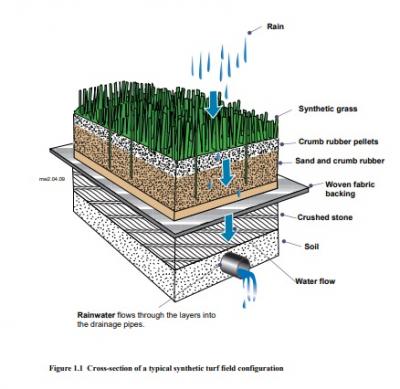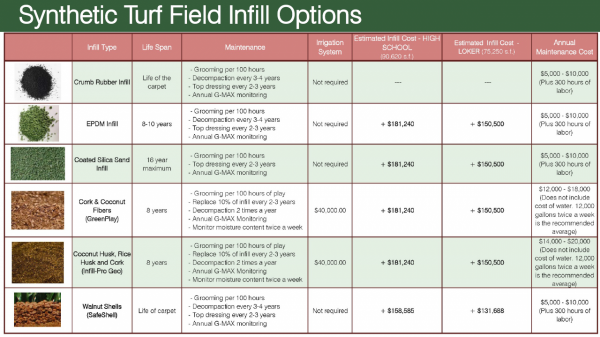What about concerns with the materials like crumb rubber infill and plastic grass fibers?
The Town will only purchase a turf carpet that is manufactured without PFAS chemicals. The infill will be a virgin (non-recycled) EPDM rubber. The Town will continue its existing operating procedures to avoid excessive heat exposure with respect to use of the field during the summer.
BACK TO FAQ
Concerns have been raised by the public about the potential health risks from playing on synthetic turf fields containing tire crumb rubber infill. Studies to date have not shown an elevated health risk from playing on fields with tire crumb rubber, but the existing studies have been limited. The U.S. Environmental Protection Agency (EPA), the Centers for Disease Control and Prevention/Agency for Toxic Substances and Disease Registry (CDC/ATSDR), and the U.S. Consumer Product Safety Commission (CPSC) have noted the need for additional information to be able to evaluate potential health risks from exposure to tire crumb.
Recently, similar concerns regarding synthetic turf blades/fibers have been raised. The Town was informed that the turf field at Wayland High School was manufactured with no PFAS. The Town is currently seeking a written guarantee from the manufacturer. The Town would require in the Loker field specifications that the turf carpet cannot be manufactured with materials containing PFAS. 
- What are PFAS? There are around 4,700 chemicals in the PFAS family, and they all have two things in common: 1) They’re all man-made. 2) They contain linked chains of carbon and fluorine. PFAS chemicals don’t degrade easily; sometimes called “forever chemicals.” Studies estimate that 98% of Americans have detectable levels of PFAS in their blood.
- Where do they come from? PFAS chemicals were invented in the 1930s, and are used in many common items, like paper food packaging (think microwave popcorn bags and pizza boxes), stain-proof rugs, waterproof clothing, some types of dental floss and nonstick cookware. The bottom line is there are still PFAS chemicals in the everyday products we buy.
Questions were raised regarding the decision on the infill for the project. The Recreation Commission initially selected crumb rubber for the infill. Of the 16 different types of infill the Town considered, from walnut shells to cork to coconut to crumb rubber, the Town initially chose to use crumb rubber infill. Based on the concerns raised surrounding the safety of crumb rubber, the Recreation Commission has revised its recommendation to upgrade the infill of choice to virgin crumb rubber. Virgin crumb rubber is not made from ground-up truck tires. The main advantage virgin crumb rubber has over standard crumb rubber is it is a virgin product, meaning it is made from known components that can be modified to enhance the product and avoid specific chemicals. Rubber is the most widely used and researched material for synthetic fields. The decision on infill material was made after thorough analysis the materials including information from a Weston & Sampson toxicologist and analysis of over 80 bodies of research compiled by the School Committee.
Infill
Below is a table describing the various infill options considered.
Virgin crumb rubber refers to Ethylene Propylene Diene Monomer (EPDM), which is manufactured for the purpose of a sports field infill, as opposed to using rubber from recycled ground up truck tires.The decision to use this infill was made after thorough analysis by a toxicologist, community input, including by the Recreation Commission, and the Permanent Municipal Building Committee (PMBC), and analysis of over 80 bodies of research compiled by the School Committee. The Town assessed 16 different types of infill from walnut shells to cork to coconut to crumb rubber.
Virgin crumb rubber is not made from ground-up truck tires. Rubber is the most widely used and researched material for synthetic fields.
WHS Stadium Turf Specifcations: A resilient infill system, consisting of a course, rounded, uniformly sizedsilica sand and graded virgin EPDM crumb rubber. (Minimum total weight of 7 lbs. (4 lbs sand and 3 lbs rubber) per square foot with a 57/43 sand and rubber ratio – No Exceptions). Infill shall be installed to a minimum height of 2 inches providing no more than ½ inch exposed fiber. Or an Engineer approved equivalent.
A question was raised regarding whether artificial turf fields may pose greater danger of severe burns and heat illness during summer weather since field surface temperatures are higher on artificial turf fields; surface temperatures can reach as high as 200 degrees Fahrenheit. Even in New England, turf surface temperatures can get hot. We've seen turf surface readings in Wayland as high as 168 degrees on July 3, 2018. (The natural grass was 125 degrees that day). The Recreation Department, summer camps and school athletics all have protocols in place to keep users off hot fields (grass or turf). Existing Operating Procedures that have been in effect since the first artificial turf field was installed at the Wayland High School Stadium 12 years ago continue to help keep users safe during Heat Warnings and Heat Advisories.


